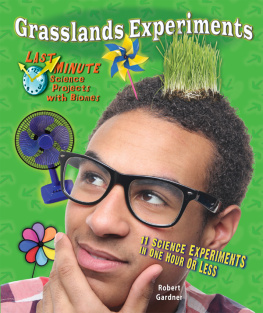Science Projects, Just in Time!
Have you waited until the last minute to start your science project? Dont worry, award-winning author Robert Gardner has you covered. Most of these experiments about the taiga biome can be done in an hour or less! There are also a few longer experiments for the budding scientist and ideas for science fair projects in case you have more time!
This creative series tackles science concepts that are important for students to learn in a simplified and meaningful way.
Helen Hess, PhD, Series Science Consultant
Professor of Biology
College of the Atlantic
Bar Harbor, Maine
About The Author
Robert Gardner is an award-winning author of science books for young people. He is a retired high school teacher of physics, chemistry, and physical science. In 2010, he received the Lifetime Achievement Award in Hands-On Science Writing from AAAS/Subaru Science Books & Films.

If you have a science project that is due soon, maybe tomorrow, this book will help you. It has experiments about taiga (northern forest) biomes. Many of the experiments can be done in less than one hour. An estimate of the time needed is given for each experiment. Perhaps you have plenty of time to prepare for your next science project or fair. You can still use and enjoy this book.
Many experiments are followed by a Keep Exploring section. There you will find more ideas for science projects. The details are left to you, the young scientist. You can design and carry out your own experiments, under adult supervision, when you have more time.
For some experiments, you may need a partner to help you. Work with someone who likes to do experiments as much as you do. Then you will both enjoy what you are doing. In this book, if any safety issues or danger is involved in doing an experiment, you will be warned. In some cases you will be asked to work with an adult. Please do so. Dont take any chances that could lead to an injury.
A biome is a region of Earth that has a particular climate. The plants and animals that live in a biome are quite similar all around the world. This book is about taiga biomes, also called boreal forests or northern coniferous forests. But there are other biomes. Earths land biomes also include deserts, tundra, grasslands, rain forests, and temperate forests.
Taiga biomes extend around the Northern Hemisphere. They are found between tundra to the north and grasslands or temperate forests to the south. In general, they lie between 45 and 65 degrees north latitude. (A look at a world map or globe will reveal why there are no taiga biomes in the Southern Hemisphere.)
Taiga biomes receive between 12 and 33 inches of precipitation a year. That is approximately the same amount as grassland biomes. However, they are wetter and colder than grasslands. Winter temperatures range between 45 and 1C (49 to 30F). Summer temperatures are usually between 7 and 21C (19 to 70F). But summer air can reach 30C (86F) with very high humidity. Taigas cooler temperatures reduce evaporation. That is why taiga biomes are wetter than grasslands. It helps preserve taigas wetlands, ponds, lakes, bogs, and mossy forest floor.

Image Credits: TT/iStock
The taiga is also called a northern coniferous forest.
Taiga soil is shallow and acidic. Low temperatures reduce the rate of decomposition. As a result, the forest floor has a lot of slowly decaying or undecayed plant matter. There are also herbs, mushrooms, lichens, and mosses. Where sunlight reaches the forest floor, you might find blueberries in the summer, baby willows, alders, and fungi.
"Coniferous forest" describes the biome quite well. Most trees are conifersspruce, pines, fir, and tamarack. But there are also broad-leafed treesbirch, alder, poplar, balsam, aspenparticularly along a taiga biomes southern border. In Siberia, tamarack, which sheds its leaves in autumn, is the dominant species.
Sometimes the North American taiga is called the spruce-moose forest! This is because it has an abundance of spruce trees and moose. But there are other animalsbear, beavers, martens, mink, lynx, foxes, wolves, wolverines, muskrats, arctic hares, squirrels, voles, and weasels. In the winter, only thirty bird species brave the cold. Among them are gray owls, ptarmigans, and whooping cranes. In the summer, millions of birds (more than three hundred species) from as far away as the tropics migrate to the taiga to nest and breed. They are drawn there by an abundance of insects. Those insects include flies, mosquitoes, beetles, larch sawflies, spruce budworms, and other bugs. The swarms of insects can send hikers searching for shelter. Because of the temperature, few cold-blooded animals, other than insects, can be found in the taiga. Insect eggs can survive the winter and hatch when warm weather arrives. Reptiles and amphibians cant endure the cold, but fish are common in the biomes lakes and rivers.
Migrating animals, other than birds, include butterflies, salmon, and caribou. Caribou spend the winter in the taiga and the summer in the colder tundra to the north.

Image Credits: Thinkstock: Frank Hildebrand/iStock
Moose make their home in the taiga.
Not a lot of snow falls in the winter, but it is cold all season and sunlight is limited. As a result, snow doesnt melt. It accumulates and deepens. Some animals, such as voles, weasels, and hares, make tunnels under the snow. A foot under the snows surface, the temperature is a relatively toasty 0C (32F). The deep snow insulates these animals from the much colder air above. The insulation, their furry bodies, and the food they store underground keep them warm.
Large animals with long legs, such as moose, can walk through the snow. Others, such as lynx and arctic hares, have broad paws. Their broad paws act like snowshoes, allowing them to walk on top of the deep snow.
To do experiments the way scientists do, you need to know about the scientific method. It is true that scientists in different areas of science use different ways of experimenting. Depending on the problem, one method is likely to be better than another. Designing a new medicine for heart disease and finding evidence of water on Mars require different kinds of experiments.

Image Credits: Shutterstock.com: BMJ
These migrating caribou are in Alaska during the fall.
Despite these differences, all scientists use a similar approach as they experiment. It is called the scientific method. In most experimenting, some or all of the following steps are used: making an observation, coming up with a question, creating a hypothesis (a possible answer to the question) and a prediction (an if-then statement), designing and conducting an experiment, analyzing results, drawing conclusions about the prediction, and deciding if the hypothesis is true or false. Scientists share the results of their experiments by writing articles that are published in science journals.
You might wonder how to use the scientific method. You begin when you see, read, or hear about something in the world that makes you curious. So you ask a question. To find an answer, you do a well-designed investigation; you use the scientific method.






















